From its official greenlighting in 1992, Disney’s Animal Kingdom stood to be unlike any other Disney Park on Earth – and more importantly, unlike any zoo you’d find closer to home.
Imbued with the artistic and philosophical foundation built by lead designer Joe Rohde and his team of artisans, travelers, engineers, storywriters, and designers, the park would set out to celebrate “animals real, ancient, and imagined.” Of course, it’s the “ancient and imagined” that so capture the imaginations of Disney Parks enthusiasts, via plans for two lands that remain among the most mythologized in Imagineering’s never-built archives…
Beastly Kingdom
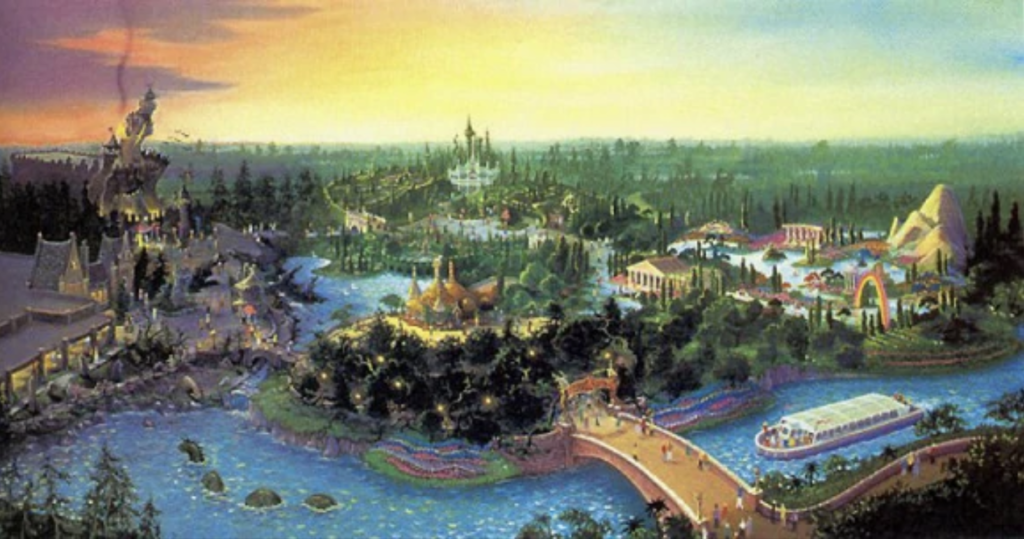
To this day, the amorphous concept of Beastly Kingdomme remains one of the most legendary never-built projects in Imagineering’s archive. Crossing a bridge branching off of Discovery Island, this land would’ve given Animal Kingdom an ode to “imagined” animals. And just like the mythic creatures that would serve as its inspiration, Beastly Kingdomme would be a land of extremes, entered via a forking path in a dark forest…
One path would lead to the land’s “light” half – a Grecian garden of bubbling springs, white marble, crawling vines, and leaping fountains reigned over by Mount Olympus. A tranquil family boat ride through Fantasia’s “Dance of the Hours” segment (with its dancing hippos, ostriches, and alligators) would be a highlight and provide Animal Kingdom with a much-needed fanciful family dark ride.
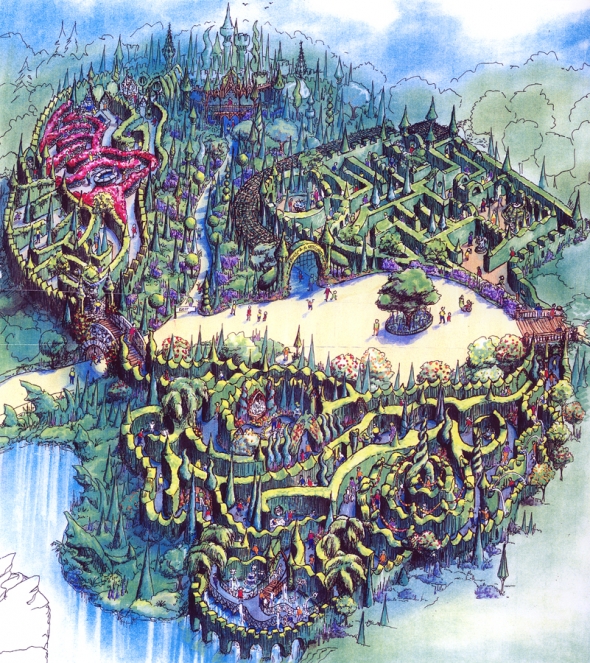
But the attraction fans most muse about is Quest for the Unicorn, an immersive, interactive walkthrough. Only those who could locate and awaken the four bronze guardians hidden in the hedge maze would be rewarded with the code necessary to enter the Unicorn’s Grotto for a face-to-face encounter with the steed.
The other path would take on a very different tone, leading into a gnarled, scorched, dark evergreen forest lit by torches and lanterns. Eventually, these twisted woods would empty into a cold, stone village populated by inns, taverns, and shops resembling a storybook medieval town.
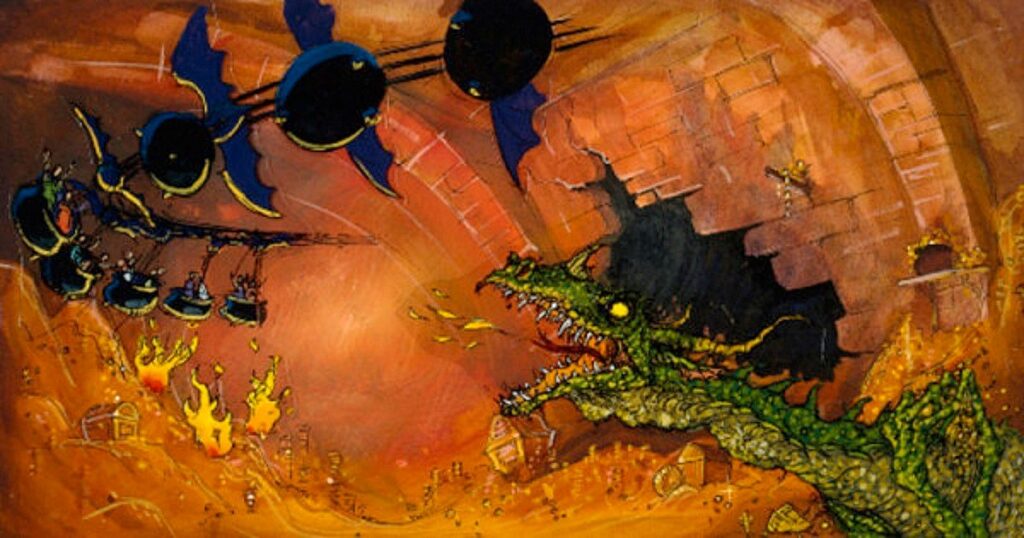
Shopkeepers would always have their eyes turned nervously skyward, wary of the horrific fire-breathing dragon that ruled the land. Look no further than the Dragon’s Tower – the land’s central icon and E-Ticket – a thrilling dark ride / coaster deep into the abandoned castle that served as the Dragon’s roost.
Beastly Kingdom would certainly set Disney’s Animal Kingdom apart from any local zoo, and infuse some much-needed Disney identity into the park. But it wasn’t alone.
Dinoland, U.S.A.
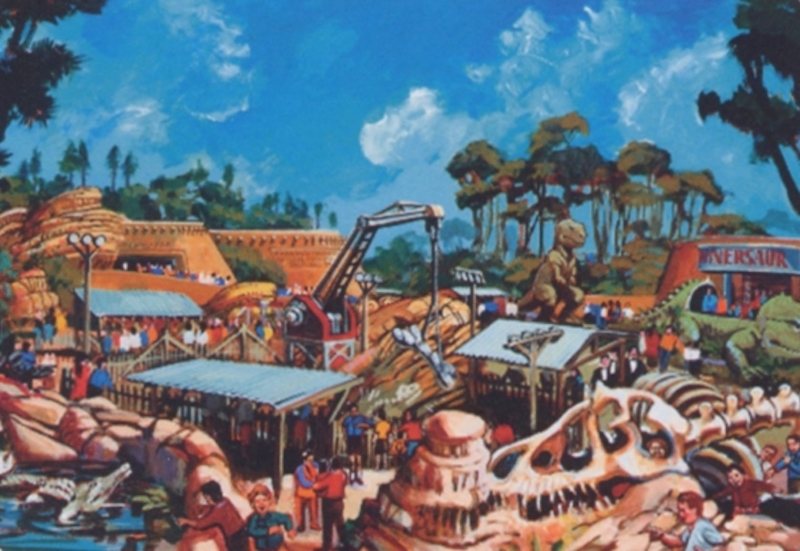
At least according to concept art developed in the early ’90s, Animal Kingdom’s land themed to “ancient” animals went through a number of iterations, including some that would’ve taken us back in time to a prehistoric world.
Ultimately, though, examining humanity’s relationship with dinosaurs lead designers down a different path. Compared to the fairytale, far-flung Beastly Kingdomme, the Dinoland sketched out for Animal Kingdom was a world away… by being a whole lot closer to home. Here, dinosaurs would be seen in the context of their relationship with humans: icons of pop culture.
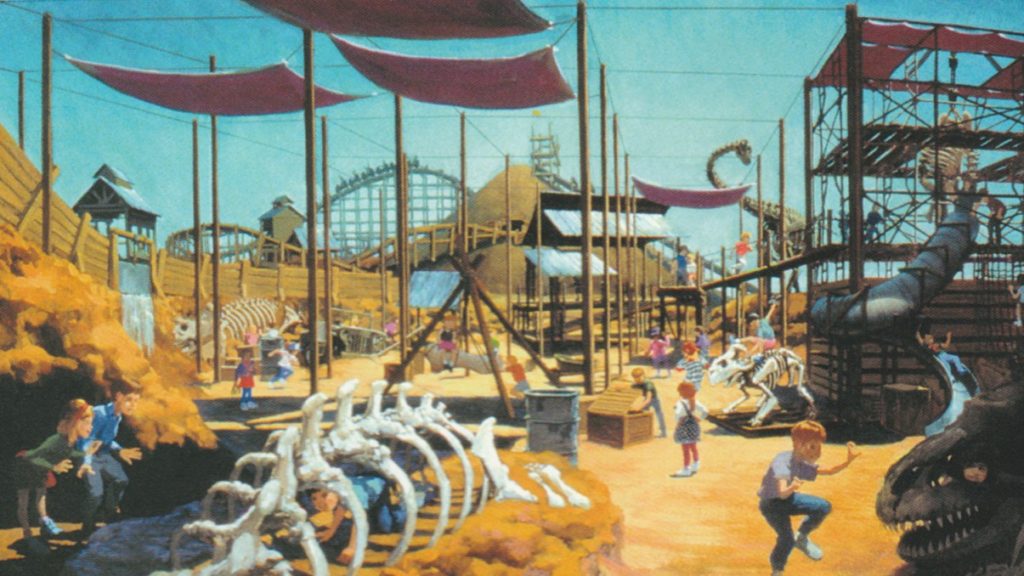
Set along a remote U.S. Highway somewhere in the southern United States, quiet Diggs County was barely more than a blip on the map until 1947 when the fossil find of the century changed it all. Suddenly, the quiet patch of land became a paleontological paradise attracting not only college students and scientists, but family-packed sedans looking for roadside attractions on their family vacations. Enterprising locals cashed in on their sleepy town’s new notoriety by embracing their newfound roadside attraction status.
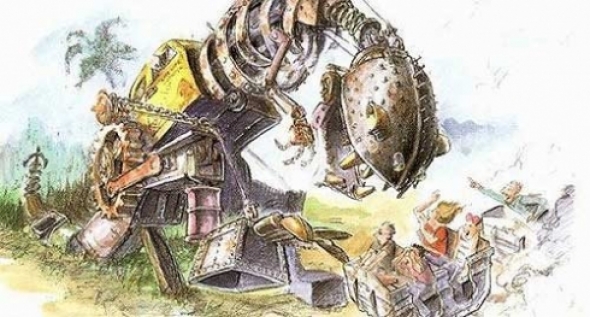
That’s why the land’s reigning E-Ticket would’ve been The Excavator – a rumbling roller coaster (made of steel, but disguised as wood like Disney California Adventure’s Incredicoaster) constructed around and through inactive dig sites, racing through trenches, diving into tunnels, and shambling past artisan “dinosaurs” constructed of reclaimed digging equipment. (Legendary in its own right, the Excavator made it onto our must-read list of Possibilitylands: Never-Built Disney “Mountains.”)

Like Asia and Africa, this Dinoland would also have a “safari” ride, giving guests the opportunity to see living dinosaurs in their natural habitat. How? That’s proprietary. But suffice it to say that in this Dinoland, the scholarly Dino Institute that had set up shop in Diggs County would indeed offer just the kind of sight-seeing tours that would make its director, Dr. Marsh, proud.
Seated aboard lumbering ankylosaurus (no doubt to blend in), guests would pass through a time machine and emerge in a primeval world. With both indoor and outdoor scenes, this dark ride would’ve given guests a sort of “Jungle Cruise”-esque ride through the Cretaceous, passing packs of Hadrosaurs, feuding Triceratops, a family of feeding Tyrannosaurus rex (safely across a primordial river), and an exciting, frightening finale ambush by a pack of Velociraptors.
Dragons fall, dinosaurs rise
For decades, Disney Parks enthusiasts have agonized over what Disney’s Animal Kingdom might be like if it had only opened in 1998 according to the built-out master plans envisioned as late as 1994. And as the rare Member-exclusive park site plan shows, its southern half would’ve been substantially different than the park we know today…
For one, the park would’ve opened with four solid E-Tickets (Dragon’s Tower, The Excavator, Tiger River Run, and Kilimanjaro Safaris) plus at least two family dark rides (the boat ride through Fantasia and a journey through the primeval world). More importantly, though, both Beastly Kingdom and Dinoland would’ve clearly elevated Disney’s Animal Kingdom to a “full-day” park, and something far more than a zoo. So what happened?
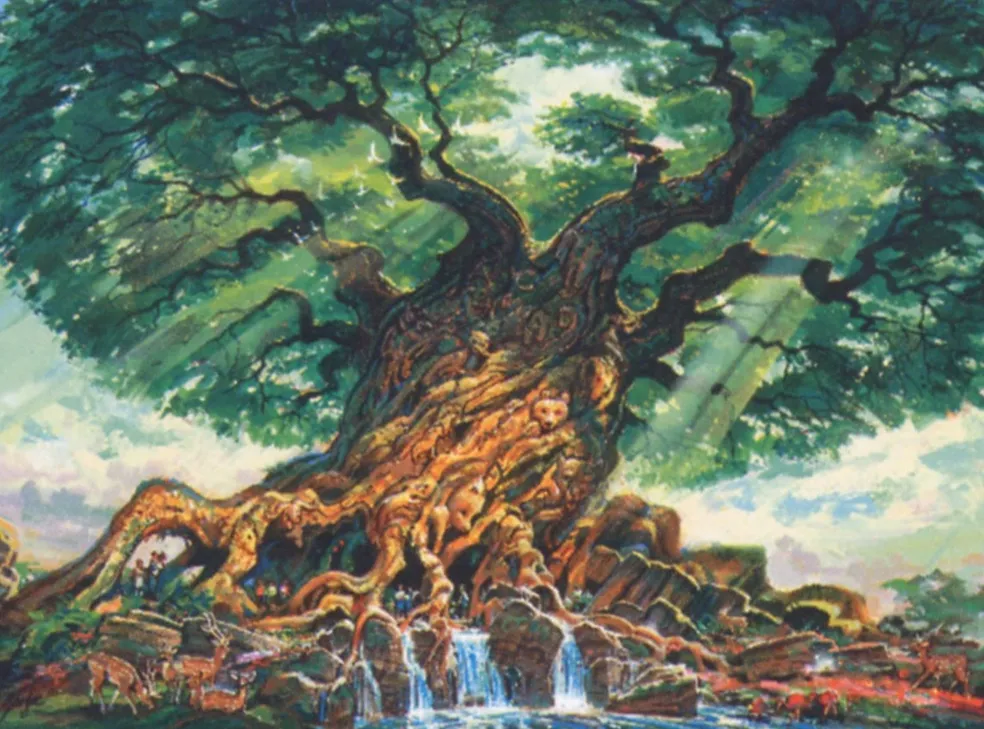
At least according to oral tradition, by mid-1994, a still Paris-weary Michael Eisner was growing concerned by the ballooning price tag for Disney’s Animal Kingdom – and particularly, how much of the park’s $650 million budget was earmarked for backstage animal care facilities that guests would never even see. As the project’s proposed budget neared $1 billion, Eisner reportedly requested cuts to the park’s more flowery offerings.
Though unconfirmed (and almost certainly embellished), it’s often said that the Imagineering teams developing Beastly Kingdom and Dinoland essentially went head-to-head, each trying to sell Eisner on why their land ought to be given the greenlight to make it into the finalized Animal Kingdom… and more importantly, how they could do it inexpensively.
By time the park was officially announced in 1995, Beastly Kingdom wasn’t among its lineup. (Joe Rohde, for his part, countered fans’ narrative that the land was “cut” or rescheduled for a “Phase II” expansion by tweeting that the land had not been funded or officially greenlit anyway, and that the seeming allusions to it – like a dragon in the park’s logo and “imagined” creatures in its Dedication – were more in the spirit of “projections of future development” than explicit echoes of the Beastly Kingdom project, much less promises that it would happen eventually.)
If indeed Dinoland had “won out” over Beastly Kingdom, though, it would make sense. After all, by the mid-1990s, there were a few very compelling reasons – both inside and outside of the Walt Disney Company – to push ahead with a dinosaur-themed land for Disney’s Animal Kingdom…
1. Prehistory in pop culture
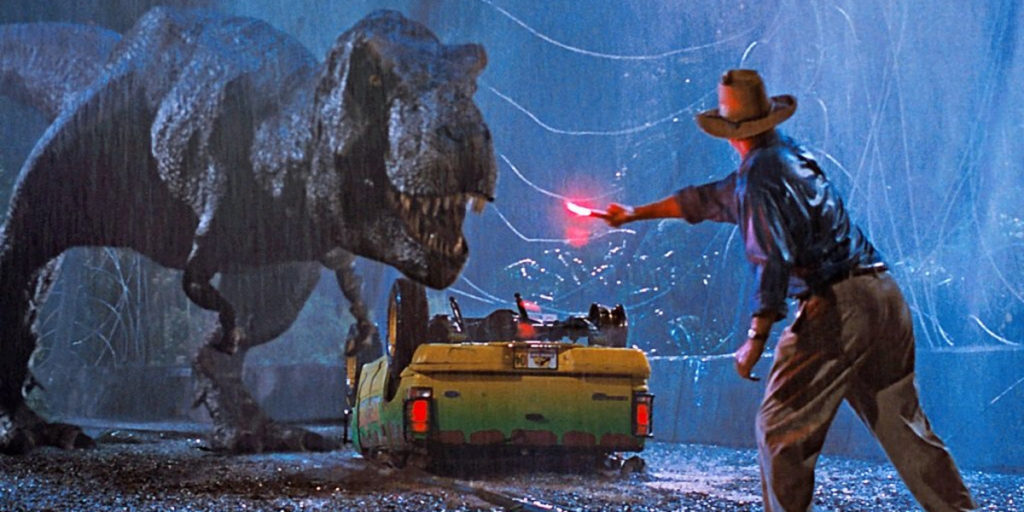
Debuting Summer 1993 – just as designs were being locked in for Disney’s Animal Kingdom – Steven Spielberg’s Jurassic Park served as a pivotal moment in pop culture. The stunning film used then-unthinkable computer generated imagery and advanced Audio-Animatronics to bring dinosaurs to life, quickly becoming the highest-grossing film ever, and certainly anchoring dinosaurs’ place in the zeitgeist for generations.
To that end, Universal Studios Hollywood in California would open its Lost Legend: Jurassic Park – The Ride in 1996, and rumors already held that Universal planned to weaponize the franchise in Disney World’s backyard by making an entire Jurassic Park land the anchor of its own 21st century theme park – what would become Universal Islands of Adventure. It made sense for Disney to both capitalize on the dino-craze begun by Jurassic Park, and to steel themselves against an impending Jurassic presence in Central Florida.
2. A project in the pipeline
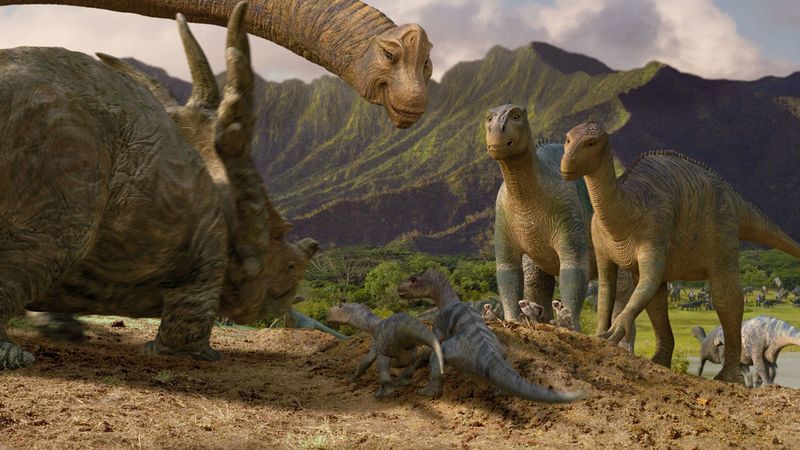
In 1994 – again, just as Animal Kingdom was moving from design to production – Eisner greenlit a film he expected would be a groundbreaking, blockbuster revolution. Combining live-action backgrounds with post-produced, CGI dinosaurs, the project was envisioned as a Jurassic Park-sized game-changer for the company… so much so that Eisner allegedly greenlit it even when the filmmakers explained that they couldn’t even begin to estimate what it would cost or how long it would take to produce.
While the movie was still early on in development, it stood to reason that a dinosaur-themed land at Disney’s Animal Kingdom would at least prime the public for a blockbuster film if not offer an opportunity for cross-promotion whenever it finally premiered.
2. Mesozoic merchandise
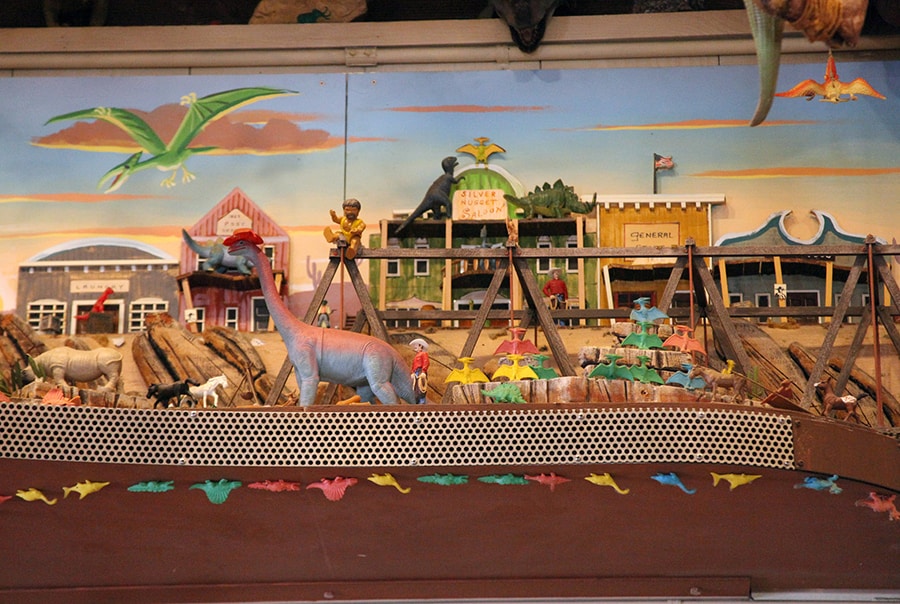
Chances are that you or someone you know went through a serious “dinosaur” phase somewhere between ages 3 and 12 (or perhaps continuing unto today for some of us). Perhaps rivaled only by cars and trucks (and of course, the scream-worthy “Dinotrux”), the merchandising opportunities behind dinosaurs were simply too guaranteed and too spectacular to pass up, especially with Jurassic Park and the then-upcoming Disney dinosaur film in the pipeline.
4. A technological breakthrough
At least according to “Disney legend,” there’s one undeniable reason both why Dinoland got the go-ahead over Beastly Kingdom, and why neither the Excavator nor the time-traveling family dark ride can be found there… One ride that changed the course of Disney’s Animal Kingdom, even from 2,500 miles away… Read on…




Re Quest of the unicorn — that sounds an awful lot like a (now-defunct) attraction called ‘Adventure’ at COSI in Columbus, Ohio. Which sounds a bit crazy, except that – if I recall correctly – Adventure was designed by a firm that was created by Imagineers who were let go after AK’s opening. (Our zoo also benefitted from this experience; there are sections built in the early 2000s that are Disney-quality, reportedly due to being designed by ex-Imagineers who had worked on AK.)
Adventure began with a pre-show explaining the premise (which, incidentally, felt very much like Indiana Jones’ in Disneyland – almost uncannily so, now that I think back on it). Upon exiting the pre-show, visitors entered an enormous set with plenty of opportunities to explore. The exhibit was essentially divided into four areas (a maze, a cavern, a gravel pit, etc.), with a “locked” central ‘observatory’. The objective was to obtain a four-piece “code”, which in turn would unlock the observatory. In each area, visitors located several ‘animal symbols’ (indicated by small bronze statues), as well as a larger “stone” statue. When visitors typed the three animals into the keypad, the (audio-animatronic) statue would “come to life”, since a little song, and display a “piece of the code”. After gathering all four pieces, visitors then went to the observatory, put the code in, and were granted entry. (This then led to a ‘second level’, far more complex than the first — almost like a predecessor to modern-day escape rooms.)
Unfortunately, it closed a few years ago, but it was one of my favorite activities in the city and immediately sprung to mind upon reading your description of Quest of the Unicorn.
Happy to provide any add’l information as I’m able — it’s been a few years since my last visit (when the space closed), but I spent enough time in there that I should have decent recollection!
Carrie! You are talking about one of my favorite things that’s ever existed – and the subject of an upcoming deep dive here. Adventure was genuinely the attraction that made me who I am. I was lucky to experience it as a kid, and then to work at COSI for about a decade after college. I’m so glad you brought up this relationship, because Quest for the Unicorn always felt like a high-capacity “twist” on Adventure, perfectly appropriate for Animal Kingdom. But wow, please stay tuned because I am worried no one’s gonna “get” my Adventure piece, so I’m glad to know that you will. Haha. Thank you!
It was always one of my fave ride at animal Kingdom
Brilliant article. I would classify this ride as a classic. Mainly because of its original concept. There might have been a plan for a future IP tie in, but this ride is original nightmare fuel. I’d say celebrate the Genious of the rides first iteration as a lost legend.